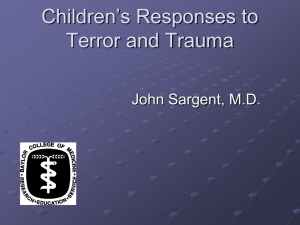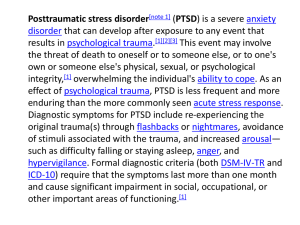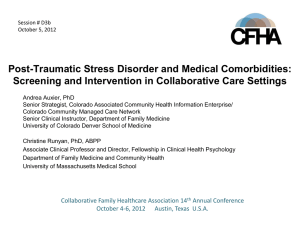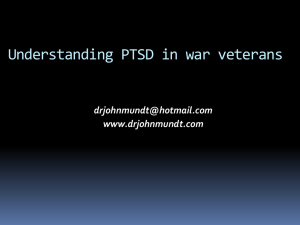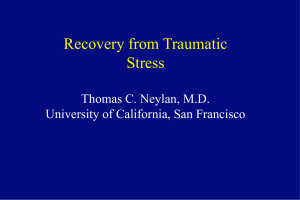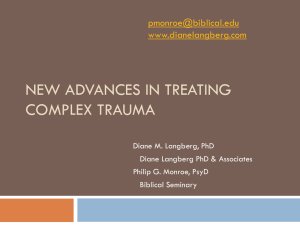Nature vs Nurture - YES! in Rock County
advertisement
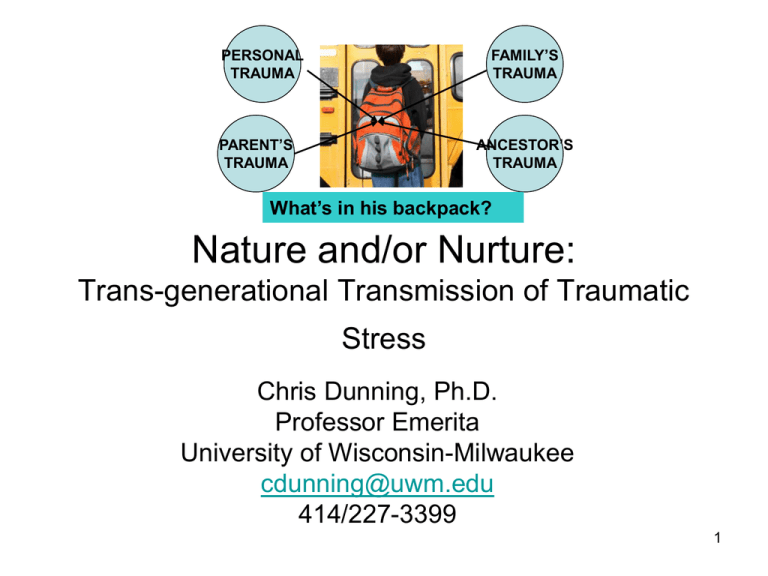
FAMILY’S TRAUMA PERSONAL TRAUMA PARENT’S TRAUMA ANCESTOR’S TRAUMA What’s in his backpack? Nature and/or Nurture: Trans-generational Transmission of Traumatic Stress Chris Dunning, Ph.D. Professor Emerita University of Wisconsin-Milwaukee cdunning@uwm.edu 414/227-3399 1 Why examine Trans-generational Transmission of Trauma? Children Bring Their Whole Lives into the Classroom • Children spend 6-8 hours a day in school. • If the school is trauma-informed, those could be hours in which the children feel understood, accepted and validated, all of which might g help them recover from trauma • Teachers who function as secondary or alternative attachment figures could provide some protection against negative developmental outcomes 2 • Education can help the children become part of society. Trauma’s Legacies YOUR STUDENT PERSONAL EXPERIENCES PARENTAL/ CAREGIVER EXPERIENCES FAMILY GRANDPARENTS’ & ANCESTORS’ EXPERIENCES 3 Let’s Talk About the Elephant in the Classroom AFFECT ATTITUDE BEHAVIOR LEARNING COGNITION 4 What Do You Have in the Classroom? • • • • • • Personal Traumas Family’s Traumas Parent’s Childhood/Adult Traumas Caregiver/Teacher’s/Staff Traumas Ancestor’s Traumas Community Traumas NOT EVERY CHILD HAS THE SAME-SIZE ELEPHANT IN THEIR BACKPACK 5 Just Because a Person Has Been in a Traumatic Event… Doesn’t Mean They are TRAUMATIZED!! 6 STUDENT LEARNING 7 Let’s Take out Personal Experience and Look Only at Inherited/Transmitted Trauma STUDENT GENETIC MAKEUP BIOLOGY SCHEMAS/BELIEFS VALUES LEARNED MODELED BEHAVIORS 8 What Makes Up a Student BIOLOGY SCHEMAS BELIEFS VALUES LEARNED BEHAVIOR Abused Child>Abusive Parent Domestic Violence>Domestic “Violentor” Victim>Perpetrator (Role Reversal) Vulnerability Trust Intent/Blame Guilt Empathy Self-Esteem Self-Worth Futuring 9 Key Developmental Capacities Affected By Trauma Ability to modulate, tolerate, or recover from extreme affect states Regulation of bodily functions Capacity to know emotions or bodily states Capacity to describe emotions or bodily states Capacity to perceive threat, including reading of safety and danger cues Capacity for self-protection Capacity for self-soothing Ability to initiate or sustain goal-directed behavior Coherent self, Identity, sense of self-worth or esteem Capacity to regulate empathic arousal Capacity to trust 10 Domains Impacted by Trauma That Affect Learning • • • • • • • Behavioral Control Cognition Attachment Dissociation Affect Regulation Physiological and Psychological State Self Concept 11 Trans-generational Trauma Attachment research shows a 75% correspondence between a mother’s attachment and that of her infant RESULTING IN… • Repetition of disturbed interactions and patterns of relationships • Repetition of abuse and maltreatment • Issues for abused parents - anxiety, compensation and reparation, envy • Re-enactment of unresolved attachment trauma 12 Transmission of Trauma from Parent to Child • “Direct and specific" transmission (a mental syndrome in the survivor parent leads directly to the same specific syndrome in the child) • Indirect and general" transmission (a disorder in the parent makes the parent unable to function as a parent which indirectly leads to a general sense of deprivation in the child). 13 Trauma Symptoms that Impact Parenting: PTSD Avoidant D. Negative alterations in cognitions and mood associated with the traumatic event(s), beginning or worsening after the traumatic event(s) occurred), as evidenced by two or more of the following: 1. Inability to remember an important aspect of the traumatic event(s) (typically due to dissociative amnesia that is not due to head injury, alcohol, or drugs) 2. Persistent and exaggerated negative beliefs or expectations about oneself, others, or the world (e.g., “I am bad,” “No one can be trusted,” "The world is completely dangerous"). (Alternatively, this might be expressed as, e.g., “I’ve lost my soul forever,” or “My whole nervous system is permanently ruined”). 3. Persistent, distorted blame of self or others about the cause or consequences of the traumatic event(s) 4. Persistent negative emotional state (e.g., fear, horror, anger, guilt, or shame) 5. Markedly diminished interest or participation in significant activities 6. Feelings of detachment or estrangement from others 7. Persistent inability to experience positive emotions (e.g., unable to 14 have loving feelings, psychic numbing) Parent’s PTSD Arousal Symptoms E. Marked alterations in arousal and reactivity associated with the traumatic event(s), beginning or worsening after the traumatic event(s) occurred, as evidenced by two or more of the following: 1. irritable or aggressive behavior 2. reckless or self-destructive behavior (alcohol, drug, eating, self-harm, high risk, promiscuity…) 3. hypervigilance 4. exaggerated startle response 5. problems with concentration 6. sleep disturbance (e.g., difficulty falling or staying asleep or restless sleep) 15 Empathic damage done to student by parent 1. 2. 3. 4. 5. 6. 7. 8. 9. 10. Sense of Self-esteem Sense of Safety Affect Regulation Ability Fear of Abandonment Fear of Rejection Trust Level Questioned Fear of Betrayal Fear of Blame Sense of Control Loss of Sense of Self In Larger Picture/Context 16 Let’s Look at Traumatized Families: Adaptational Styles (Danieli) • General family types are associated with traumatic psychological responses: – “Families of fighters,“ • Children had to adopt a “Fighter/Hero” identity to saty in family and achieve parents’ goals for recognition and redress • Contempt and intolerance for dependency, weakness, or failure • Outside world seen as oppositional so aggressive interaction the norm • Children programmed to seek validation for parents’ suffering and to make their parents’ whole 17 Adaptational Family Styles – "the Numb family," • Pervasive silence and depletion of all emotions • Parents capable of tolerating only minimal amount of stimulation • Children’s inner spontaneity and fantasy life severely limited • Parents protect each other and children protect the parents • Children adapt by numbing themselves or are perpetually angry • In attempt to please parents, try to excel in social standard of achievements • Children frequently accept outside role models over parents to know how to live 18 Adaptational Family Styles – “Those who made it.“ families • Motivated by magical fantasies during trauma • Desire to “make it big”, regain power and control – “Victim families” • Pervasive depression, fear, worry, and distrust of outside world • Symbiotic clinging within the family • Catastrophic reactions to everyday problems and situations • Guilt used as a form of control 19 Two new categories to add to Danieli's typology– 5. “Life goes on" families Conspiracy of Silence Advocacy for present and future gains Children expected to achieve 6. “Split families." – Ready acceptance of new members (“aunties”, “uncles”, “daddies”, “siblings”…) – Fluid membership-transfer between families – Toleration of independence, parentification – Creation of “new families” (eg. affiliation with gangs, cults, groups, social institutions [churches]… – Little parental oversight 20 Holocaust Link: Jewish and Native American Holocaust Survivors’ child complex • • Fixation to trauma attempts to resolve past 1. Effects • Nightmares • Perceived obligation to ancestors 2. Coping strategies • Memory Candles (Living testaments) Disenfranchised grief • Transposition Loss cannot be openly •Living in the Past & Present mourned 1. Individual • Inhibited with shame 1. 1st Generation •Post Traumatic Stress Disorder 2. Society 2. Subsequent Generations • Loss of ancestral •Historical Unresolved tradition Trauma 21 Neurobiology of Trans-generational Transmission of Trauma Caveat: The genetic model of transmission may evoke resistance because of its similarity with the Nazi ideology of purifying the gene pool of the German race, it provides a clear theoretical basis for future research. – Parental traumatization may be transmitted in the same manner as some hereditary diseases are passed on from one generation to another. – Genetic memory code of a traumatized parent may thus be transmitted to the child through some electro-chemical processes in the brain. 22 Genetic transmission The neural organization of various memory systems in the parent (e.g. hyperalertness) would lead to a similar organization and constitution in the child. Since psychic trauma is assumed to have long-term effects on the neurochemical responses to stress in traumatized parents it may also lead to the same enduring characterological deficiencies and to a kind of biological vulnerability in the child. 23 Gene Environment Interaction • New research helps answer the puzzling question of why post-traumatic stress doesn't happen to everyone who endures horrible trauma. • Researchers found that survivors of child abuse were particularly likely to have symptoms of post-traumatic stress as adults if they also had specific variations in a stress-related gene. 24 We are concerned with the gene for stress hormone systems •Norepinephrine – “revving up” hormone •Cortisol – “quieting down” hormone Both hormones are released in response to stress. They are normally in balance. 25 Stress Response • Designed to help mobilize ourselves to cope with danger by responding in one or more of the following behaviors: Withdrawal –FLIGHT Immobility-FREEZING Aggression-FIGHT Appeasement-SUBMISSION Typically, our first reaction to danger is to freeze, to stop all movement. 26 A Threat Occurs: Human Stress Response Fight/flee/freeze State of high alert, hypervigilance Action, not thought Decreased ability to think clearly or completely Extremist thinking Attention to threat – tagged for mental priority Increased aggression – loss of impulse control Dissociation buffers CNS but fragments mental functioning Speechless terror – loss of words Action is successful or not=helplessness 27 The Culprit-FKBP5 The FKBP5 gene is active in the biochemical make-up of the body's stress-response system. • Early-life abuse can result in particularly potent changes to this system as it develops — depending partly on whether or not the variations are present in the gene. • The combination of the gene variations and past child abuse were the key ingredients for the doubled PTSD symptoms when a subsequent trauma occurred • This finding suggests a gene/childhood environment interaction for adult PTSD. • Inherited variations in multiple genes, which have yet to be identified, are estimated to account for 30 to 40 percent of the risk of developing PTSD. 28 Research on Ancestral PTSD • Found that low cortisol levels were significantly associated with both PTSD in parents and lifetime PTSD in offspring, whereas having a current psychiatric diagnosis other than PTSD was relatively, but non-significantly, associated with higher cortisol levels. – “Ancestral PTSD, a putative risk factor for PTSD, appears to be associated with low cortisol level in offspring, even in the absence of lifetime PTSD in the offspring. The findings suggest that low cortisol levels in PTSD may constitute a vulnerability marker related to parental PTSD as well as a state-related characteristic associated with acute or chronic PTSD symptoms” 29 PHYSIOLOGIC DIFFERENCE Depression, Stress, or Trauma CRF Gluco Corticoid Receptors ----HYPOTHALMUS PITUATARY ADRENAL Gluco Corticoid Receptors 30 ++++ Research Findings-FKBP5 • Research examines polymorphisms (variants of a gene among a population) of a gene called FKBP5. – Protein in this gene encodes is involved in mediating the actions of the glucocorticoid receptor, which upon activation moves into the nucleus of the cell and regulates gene expression. • Researchers discovered polymorphisms of FKBP5 were correlated with increased rates of PTSD in adults who experienced traumatic stress, but only in subjects who had experienced trauma previously or who had inherited the morphism of their FKBP5 gene. 31 FKBP5 Gene • On its own FKBP5 polymporphism was not correlated with adult PTSD-Mutation only happens in early childhood under traumatic circumstances. FOR EXAMPLE A. B. A. B. Normal FKBP5 parent traumatized while serving in Iraq=no mutation Parent abused repeatedly in first 5 years of life= possibility of FKPB5 mutation which could then be passed on Child inherits mutated FKBP5 gene and never experiences a trauma=no PTSD (may have some symptoms) Child inherits mutated FKBP5 gene and experiences a trauma=substantially greater possibility of PTSD if no buffering factors 32 FKBP5 and HPA axis • Identified genes were generally involved in hypothalamic-pituitary-adrenal (HPA) axis, signal transduction, or brain and immune cell function. – FKBP5, a modulator of glucocorticoid receptor (GR) sensitivity, showed reduced expression in PTSD, consistent with enhanced GR responsiveness. – FKBP5 expression was predicted by cortisol when entered with PTSD severity in regression 33 HPA Axis Alterations PTSD Cortisol levels Glucocorticoid receptors Low Increased Negative feedback Stronger CSF CRF levels Increased Major Depression High Decreased Weaker Increased 34 What does this biological state do to the student’s body? CRH Short-term effect of cortisol Glucose release from liver and muscles ACTH cortisol Long-term effects Immune changes Loss of muscle and bone mass Loss of insulin sensitivity Hippocampus neuronal death 35 STRESS Targets for Cortisol • • • • • • • • Acute - enhances immune, Memory, energy replenishment, Cardiovascular function Chronic suppresses immune, impairs memory and attention via effects on hippocampus and PFC; Heightens fear via altering amygdala; Promotes bone & mineral loss; induces metabolic syndrome Stress induced cortisol release causes declarative memory impairment 36 Hippocampal Volume Reduction in PTSD NORMAL PTSD MRI scan of the hippocampus in a normal control and patient with PTSD secondary to childhood abuse. The hippocampus, outlined in blue, is visibly smaller in PTSD. Overall there was a 12% reduction in volume in PTSD. Bremner et al., Am. J. Psychiatry 1995; 152:973-981; Bremner et al., Biol. Psychiatry 1997; 41:23-32; 37 Effects of Increased Cortisol Effect on Child’s Brain: Loss of neurons- pruning Decreased myelination- as neurons are fired, they strengthen the myelin by using proteins, hence the brain is stronger Decreased neurogenesis- growth of new brain cells 38 STAT5B • Also less expressed in PTSD were STAT5B, a direct inhibitor of GR (glucocorticoid receptor), and major histocompatibility complex (MHC) Class II. • The Major Histocompatibility Complex (MHC) is a set of molecules displayed on cell surfaces that are responsible for lymphocyte recognition and "antigen presentation". The MHC molecules control the immune response through recognition of "self" and "non-self" 39 Early Stress and Stress Reactivity: Gene Environment Interaction • Disrupt pre-programmed, gene transcription related to stress reactivity during critical developmental period – Disrupts developmental stress circuit integration – Permanent behavioral and neurobiologic changes • Gene variants can make individual more susceptible to impact of trauma – Polymorphisms of monoamine oxidase A and alcoholism – Polymorphisms of serotonin transporter and depression – Increased risk for psychiatric disorder Caspi et al., 2003; Ducci et al., 2008 40 Implications for Educators • Safe, successful learning must maintain stress hormone levels low enough to keep the hippocampus functioning. • That's why it's so crucial for both student and teacher to know how to "apply the brakes" in class to keep the hippocampus in commission and return it to action as promptly as possible when the system goes on overload. 41 The last thing we want to happen is that we as educators add to that backpack! QUESTIONS? 42


